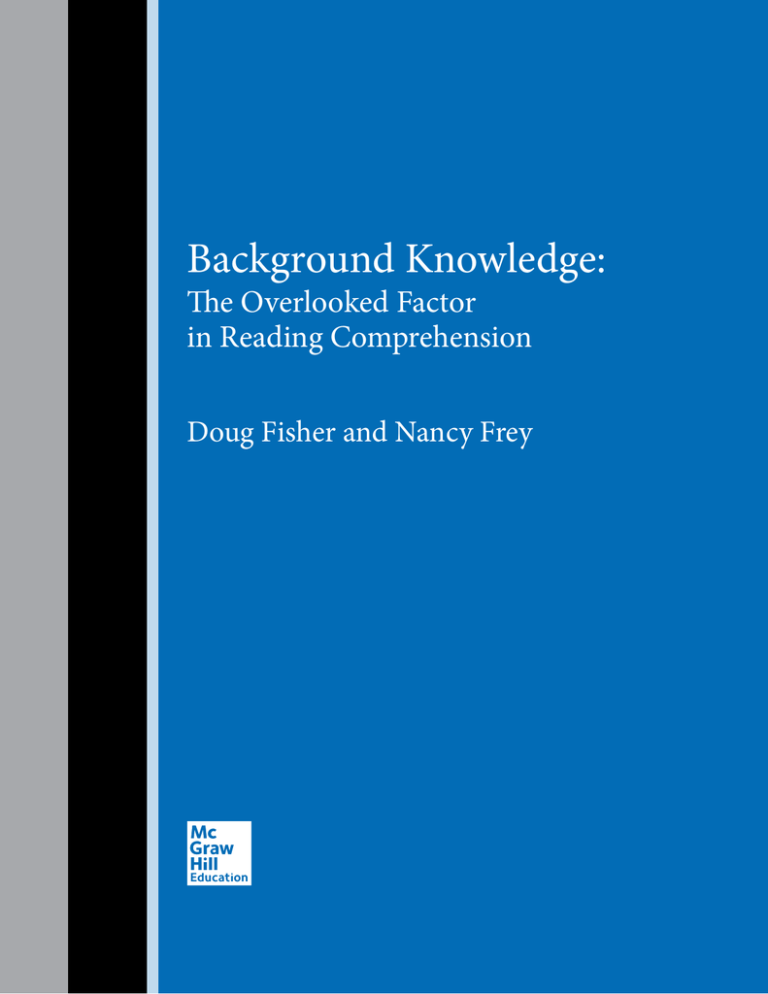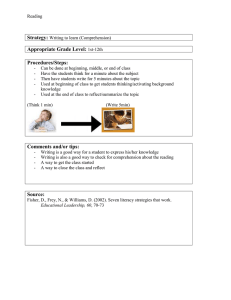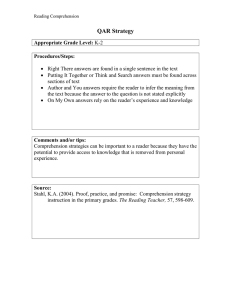Background Knowledge in Reading Comprehension: Strategies & Importance
advertisement

Background Knowledge: The Overlooked Factor in Reading Comprehension Doug Fisher and Nancy Frey Overview Background knowledge is widely discussed as a critical factor in learning, but in practice it is rarely addressed outside of assessment (Fisher & Frey, 2009; Kamil, et al., 2008). Yet it is an essential element of acquiring new knowledge. A study of students’ reading comprehension found that background knowledge and vocabulary were the strongest predictors of success, and these factors indirectly influenced whether a student would apply problem-solving strategies when meaning breaks down (Cromley & Azevedo, 2007). In other words, background knowledge is not something that merely sits dormant until it is needed; it mediates the extent to which other reading comprehension behaviors are utilized. Instruction of strategies is likely to be pointless when background knowledge is overlooked. McGraw-Hill networks™ The demand placed on background knowledge accelerates as students progress though the grade levels. Students are required to activate and apply previously learned concepts in novel ways. They must read, discuss, and write about subjects that are conceptually more difficult, often drawing from knowledge learned in other subject areas. The Common Core State Standards (CCSS) are likely to challenge students further as history/social studies and science teachers join English teachers in preparing students to comprehend informational texts. The CCSS place an emphasis on the use of complex texts that require students to read closely in order to discuss concepts, provide evidence, and support claims. The ability to do so depends in large part on the background knowledge they bring to the text. In this white paper we will discuss why background knowledge is critical to learning, as well as how it can be actively built when gaps emerge. Background Knowledge Impac ts Reading Comprehension Perhaps the most well known effect of background knowledge is its ability to directly influence the understanding of what is read (Stahl, Hare, Sinatra, & Gregory, 1991). It makes perfect sense—the more you know about a topic, the more likely it will be that you can comprehend what is written about it. For instance, when reading an abstract of a scientific article (considered to be the most difficult kind of text), educators are more likely to understand one from the American Educational Research Journal than from the American Journal of Nursing. It isn’t that you can’t decode the words or read them fluently, but rather that you don’t have the background knowledge to understand radiofrequency catheter ablation. The more extensive a reader’s background knowledge is, the easier it is to acquire new information offered by the text (Alfassi, 2004). Background knowledge also acts indirectly on reading comprehension. Fluency, an important contributor to overall reading comprehension, is heavily impacted by the level of background knowledge one possesses about a topic (Klauda & Guthrie, 2008). The ability to infer meaning in social studies texts is positively influenced by the level of background knowledge the learner has (Tarchi, 2009). Background Knowledge Affec ts Vocabulary Learning Vocabulary is the means by which learning is articulated. Whether in writing or discussion, the ability to use vocabulary accurately and incisively is a marker of one’s command of a topic. In fact, vocabulary is often used as a proxy to measure how learned a person is. Hart and Risley’s (1995) landmark study of vocabulary knowledge at school entry age accurately predicted a child’s achievement level years later. Similarly, Stahl and Fairbanks (1986) found that vocabulary knowledge correlated to grades and standardized test scores. McGraw-Hill networks™ In social studies, vocabulary is explicitly tied to huge concepts that extend beyond the sequential time lines of a single period. Words like population, revolution, and migration describe concepts that “‘clump’ information in meaningful ways [to] allow students to handle the ‘long run’ of history” (National Research Council, 2005, p. 69). Thus, a simple definition is often inadequate for explaining how integral these concepts are to the study of history or other social studies topics. This deep vocabulary meaning is built through a growing bank of knowledge that is continually reorganized and expanded. This deep bank is known as schema, a network of related knowledge that forms a mental structure to understand complex systems. As new knowledge is learned, the schema for the vocabulary becomes more sophisticated. Revolution moves from defining a single event to being able to detect the commonalities between the Glorious, American, and French Revolutions. Background knowledge about these events leads to a deeper understanding of a new event. 1 Background Knowledge Contextualizes Historical Thinking To understand history, one must be able to step away from specific content and look for enduring understandings; he or she must also closely examine and understand the time period being studied. It is not uncommon for students (and even adults) at all levels to superimpose current or personal beliefs, values, and mores onto events of the past. In some cases, these are valid. Societies of the past and present recoil at the random taking of a human life, but they differ when it comes to human sacrifice, political assassinations, crimes of passion, etc. Knowledge of the time period being studied is needed in order to understand how these events were perceived by contemporaries of the time— in other words, to contextualize. As Reisman and Wineburg (2008) state: Contextualized historical thinking is impossible to accomplish without background knowledge. One need not know everything about a historical moment, but a basic chronology and some familiarity with key developments are fundamental. . . . Background information allows students to decipher unfamiliar terms and create accurate mental images as they read. Because teachers cannot expect students to know how certain words were defined in the past or how today’s institutions differed, such information must be provided. (p. 203) Tarchi’s (2009) study of seventh-grade students found that those who possessed a solid bank of topical knowledge about history performed better on measures of reading comprehension of history texts than students who lacked this foundation. The author speculated that this was due in part to the discipline-specific need to form causal relationships between events in order to understand their significance, stating “the more facts the reader knows about a topic, the better he/she will understand a text concerning that topic” (p. 419). The background knowledge about an era serves to ground the new learning that will occur in the lesson. Instruc tional Strategies to Increase Background Knowledge McGraw-Hill networks™ Having made the case that background knowledge is vital to learning history, it is inadequate to stop there without discussing curricular and instructional approaches to building this knowledge. These techniques ensure that background knowledge is not overlooked in the rush to cultivate new learning. These include teaching conceptually, teaching for transformation, and assessing background knowledge in order to know where gaps may exist. 1) Teach conceptually. History is often unfairly perceived as the memorization of an endless list of events, dates, and historical figures. Of course, it is far more than that, but students can have a difficult time seeing the study of history as an examination of the patterns that mark the human experience, the factors that lead to the responses of leaders and societies, and the extraordinary events that have signaled change. As well, it is rare for students to appreciate that the historical record is not static, and that historians engage in debate and critical analysis of events that occurred hundreds and even thousands of years ago. But this is a logical, if incorrect, conclusion in classrooms where isolated facts are emphasized at the expense of analysis. 2 An important means for interrupting these misconceptions about the study of history is to ground learning in enduring understandings, also known as big ideas (Wiggins & McTighe, 2005). Introducing students to statements such as “People, places, and ideas change over time” anchors the study of units as diverse as the Articles of Confederation, Charlemagne, and ancient Greece. The use of enduring understandings assists students in recognizing the patterns that have defined thousands of years of human history. Understanding is further deepened through the use of essential questions that foster inquiry. Essential questions differ from enduring understandings in that they invite students to drill down within a unit of study to find details that help to answer the question. A unit on the shift from state rule through the Articles of Confederation to a central government with the Constitution asks the essential question, “How do governments change?” Thought-provoking questions help students make sense of complex concepts and create opportunities for debate and discussion because they do not have a singular, concrete answer. Importantly, the use of essential questions also fosters the kinds of critical thinking and problemsolving skills necessary for advanced learning. For example, Twyman, McCleery, and Tindal (2006) measured the achievement levels of two groups of eighth-grade social studies students. One group was taught a unit on colonial U.S. history that emphasized factual knowledge, while the other was taught the same unit conceptually through the analysis of problems of that period of history. While both groups performed similarly on a factual knowledge assessment, the conceptual group performed significantly better on measures of vocabulary and essay writing. 2) Teach for transformation. The Twyman, et al., (2006) study highlights another important practice: the need to actively engage with the content in order to make it one’s own. Students need opportunities to transform ideas in their minds and on paper (Fisher, Schell, & Frey, 2004). Simply giving them information with the expectation that they will absorb it and then regurgitate it is an outdated pedagogical notion. However, when students wrestle with ideas, the information becomes a part of their knowledge bank. Collaborative projects give students hands-on experiences to synthesize information and create new understandings (Frey, Fisher, & Everlove, 2009). For instance, when a group of students work together to create blog entries chronicling the travels of Paul, a disciple of Jesus Christ, they engage in research, clarify one another’s thinking, and write in the character of this historical figure. When students learning about Jamestown and Roanoke work in groups to scout a location for the settlements, they analyze maps, consider the needs of the settlers, and factor in what little knowledge the settlers would have had of the native people who lived there. In each example, students transform the information though oral and written language, and solidify their background knowledge to be used in subsequent lessons. 3) Assess background knowledge. Assessment should occur before and during instruction, and not just in summative exercises at the end of a unit. Regarding background knowledge, it is valuable to determine what will be needed and assess the extent to which students possess it. If and when gaps are noticed, the teacher can actively build it to facilitate new learning. We think of background knowledge as falling into two categories: incidental and core. Incidental knowledge may be interesting but peripheral to the main concepts, while core knowledge is essential to understanding the new concepts that will be taught (Fisher & Frey, 2009). For example, knowing that the ancient Greek and Roman empires have influenced Western democratic practices for two millennia is core background knowledge for a unit on the American Revolution, but knowing about Greek mythology is incidental for the same unit of study. McGraw-Hill networks™ Once core background knowledge has been identified, it can be assessed through the use of an anticipation guide (Tierney & Readance, 2004). Such guides are comprised of five to ten short written statements that students respond to as true or false. For example, an anticipation guide for the American Revolution unit might include items such as “The birth place of democracy is Athens” (true), and “The Greeks were responsible for developing the first republic” (false). Student responses to these and other statements provide insight into whether they have sufficient background knowledge for the new information they will be learning. An additional advantage of using anticipation guides is that they activate background knowledge by signaling what kinds of information the students will be using during the new unit of study. 3 Conclusion In the rush to teach new information, it can be tempting for educators to overlook background knowledge. But to do so is to build on an unstable foundation. Background knowledge has a profound influence on students’ ability to comprehend what they read. Its effect can be defined directly, as in knowledge of the topic, as well as indirectly, especially in the ability to resolve problems when meaning is lost. Evidence of one’s background knowledge can also be seen in the vocabulary used in oral and written language. Importantly, the ability to acquire new vocabulary is linked to background knowledge. Background knowledge has an equally strong effect on students’ ability to contextualize historical learning. Without knowledge of the broad patterns of human history, it is nearly impossible to understand the forces that influenced the time period. McGraw-Hill networks™ The good news is that there are many curricular and instructional practices that can positively influence activation of background knowledge. First, it is useful to teach patterns in history by explicitly identifying the enduring understandings that transcend a single period. In addition, essential questions invite students to examine the details of a time or place in order to answer thought-provoking questions. It is useful to use assessment measures of background knowledge, such as anticipation guides, in order to examine how strong students’ foundational knowledge is, as this provides insight into what should be taught next. By using approaches such as these, we can ensure that background knowledge is not overlooked. References Alfassi, M. (2004). Reading to learn: Effects of combined strategy instruction on high school students. The Journal of Educational Research 97(4), 171–184. Cromley, J. G., & Azevedo, R. (2007). Testing and refining the direct and inferential mediation model of reading comprehension. Journal of Educational Psychology, 99(2), 311-325. Fisher, D., & Frey, N. (2009). Background knowledge: The missing piece of the comprehension puzzle. Portsmouth, NH: Heinemann. Fisher, D., Schell, E., & Frey, N. (2004). “In your mind and on the paper”: Teaching students to transform (and own) texts. The Social Studies Review, 26-31. Frey, N., Fisher, D., & Everlove, S. (2009). Productive group work: How to engage students, build teamwork, and promote understanding. Alexandria, VA: ASCD. Hart, B., & Risley, T. R. (1995). Meaningful differences in the everyday experiences of young American children. Baltimore, MD: Paul H. Brookes. Kamil, M. L., Borman, G. D., Dole, J., Kral, C. C., Salinger, T., and Torgesen, J. (2008).Improving adolescent literacy: Effective classroom and intervention practices: A Practice Guide (NCEE #2008-4027). Washington, D.C.: National Center for Education Evaluation and Regional Assistance, Institute of Education Sciences, U.S. Department of Education. Retrieved from ies.ed.gov/ncee/wwc. Klauda, S. L., & Guthrie, J. T. (2008). Relationships of three components of reading fluency to reading comprehension. Journal of Educational Psychology, 100(2), 310-321. National Research Council. (2005). How students learn: History, mathematics, and science in the classroom. Committee on How People Learn, A Targeted Report for Teachers, M. S. Donovan and J. D. Bransford, Eds. Division of Behavioral and Social Sciences and Education. Washington, D.C.: The National Academies Press. Reisman, A., & Wineburg, S. (2008). Teaching the skill of contextualizing in history. The Social Studies, 99(5), 202-207. Shanahan, T., & Shanahan, C. (2008). Teaching disciplinary literacy to adolescents: Rethinking content-area literacy. Harvard Educational Review, 78, 40-59. Stahl, S. A., & Fairbanks, M. M. (1986). The effects of vocabulary instruction: A model-based metaanalysis. Review of Educational Research, 56(1), 72-110. Tarchi, C. (2009). Reading comprehension of informative texts in secondary school: A focus on direct and indirect effects of reader’s prior knowledge. Learning and Individual Differences, 20, 415420. Tierney, R. J., & Readance, J. (2004). Reading strategies and practices: A compendium (6th ed.). Boston: Allyn & Bacon. Twyman, T., McCleery, J., & Tindal, G. (2006). Using concepts to frame history content. Journal of Experimental Education, 74(4), 331-349. Wiggins, G., & McTighe, J. (2005). Understanding by Design (2nd ed.). Alexandria, VA: Association for Supervision and Curriculum Development. McGraw-Hill networks™ Stahl, S. A., Hare, V. C., Sinatra, R., & Gregory, J. F. (1991). Defining the role of prior knowledge and vocabulary in reading comprehension: The retiring of number 41. Journal of Reading Behavior, 23, 487–508. mcgrawhillnetworks.com SS 11 M 8353 7/13 1-800-334-7344




